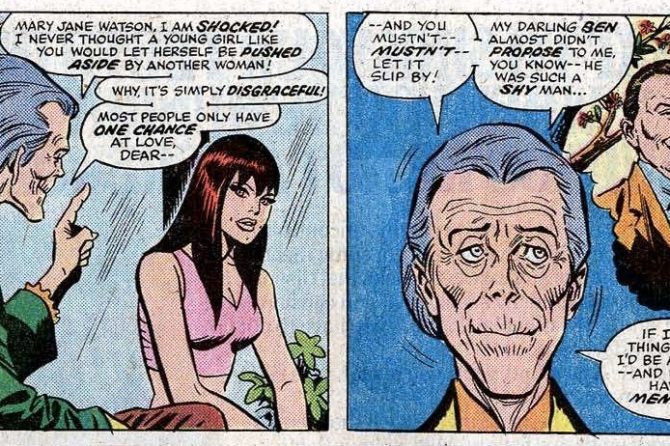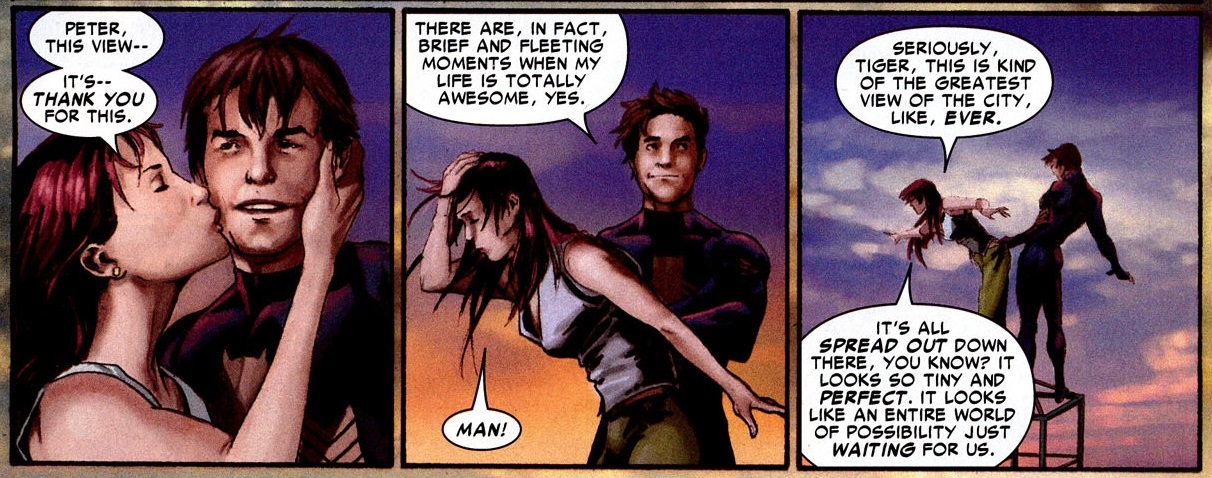In part 3 I said that the Venom was a victim of fan presumptions that weren’t in line with his actual original concept. Today we’re going to look at part of what that actual original concept was. SPOILERS Venom was the original ‘Creepy Stalker Loser’ of the Spider Franchise.

Unseen stalker
I appreciate that I might have come off as rather audacious or condescending (or both) the part 3 when I basically said most readers were judging Venom in ASM #300 by an unfair set of criteria.
Allow me to defend my view by elaborating further on what the actual intentions behind Venom were whilst primarily addressing this criticism from part 1
- Other versions of the character (such as Spider-Man the Animated Series, Spider-Man 3 and the Spectacular Spider-Man Animated Series) all make Brock to be a much better dark reflection of Spider-Man than the original comic book version
As I discussed in part 1, Michelinie’s conception of Venom stemmed primarily from wishing to find an opponent for Spider-Man who was invisible to his Spider Sense. This was emphasized in Venom’s first two off panel appearances where Peter makes note of the lack of warning from his spider sense.


Obviously not having any warning from his spider sense would make Michelinie’s new villain dangerous in a fight, but in these two appearances he’s chosen to build Venom up as an unseen assailant to Peter Parker, not Spider-Man. In the latter instance the assailant even targeted Peter when he was using his powers but was out of costume.
As far as establishing this mysterious individual as a threat this was an ingenious move as it killed three birds with one stone.
By having Peter attacked in his civilian identity it undermined two essential functions of spider sense. Namely that it protects Peter physically but also that he can rely upon it to help him keep his identity a secret. And with these attacks (especially the second one) it is all but confirmed that whoever this assailant is, they are aware of Peter’s double life.
Immediately any reader pondering Peter’s attacker would realize the severity of the danger Spidey was in. He’s under threat from an unknown enemy who knows who he is, possibly knows how to track him down and his usually reliable spider sense can’t warn him of the assailant’s presence or hostile actions.
These early hints of Venom convey him as insidious and creepy as opposed to the brute force powerhouse we’re more familiar with today. And of course when you think about it, portraying Venom this way early on is the most obvious idea in the world when your villain’s central gimmick (and original source of inspiration) is that they are invisible to Spidey’s in-built danger alarm. In fact such a thing had already been done in the classic ASM #39 where the Green Goblin followed Peter Parker after disabling his spider sense through a chemical concoction.
This build up underscores my central argument for this instalment.
That is that, despite media and later renditions to the contrary (or any fan presumptions), originally Venom was never intended as a ‘dark reflection of Spider-Man’; or at the very least that wasn’t the main idea. He was also not supposed to be a villain with a significant link to Peter’s life.
The true key to understanding Venom’s early core concept is that he was in fact…a stalker.
More specifically he’s the equivalent of a celebrity stalker, Spidey being the celebrity in question.*
Visual shorthand
When I say Venom was a stalker I do not merely mean that he literally stalked our hero. After all the Green Goblin, Harry Osborn, the Puma, Kraven the Hunter and even Mac Gargan (before he became the Scorpion) all did that too.
What I mean is unlike those other characters Venom was built around the central idea of him being a stalker. And not in an ‘urban hunter’ way like Puma or Kraven, where the characters are understood to be literally part-animal predators or engage in hunting as a form of ritual honour.
I mean that through the artwork and his actions, the early hints at Venom coded him in line with the types of creepy stalkers you hear about in the news. The people who in our cultural stereotypes of them are depicted as peeping around corners or keeping to the shadows, binoculars or long-lens camera in hand ready to steal a glance at their target for whatever twisted reasoning is going on in their heads. Basically those heavy breathing weirdos you’ve seen in a dozen films or TV shows.
Whilst Venom doesn’t directly conform to that described stereotype his actions and portrayals clearly code him as such.
Just take another look at Web #18 and #24. It can all too easily be read as touching upon ideas you’d find in a stalker storyline, especially since (ala Web #24) this assailant is apparently following Peter and striking from the shadows, only to disappear again.
Cut to ASM #298 and we get a wall of Spider-Man pictures and news clippings in what looks like a grim little apartment that Venom, clad in shadows is musing over.

Again this is obviously visual shorthand for textbook stalker behaviour. This is emphasized further in ASM #299 where Venom is fully unveiled and the scene is played to maximize a sense of creepiness and terror. The use of Mary Jane enhances this further. She is an innocent and unarmed woman who’s being accosted in the ‘safe space’ of her and our hero’s home.

The scene (specifically in having a defenceless woman confronted by a horrible ‘monster’) is at least somewhat reminiscent of countless horror movies, in particular ‘slasher’ movies like Halloween or Friday the 13th which had a certain degree of popularity at the time. Whatever you think about the appropriateness of using Mary Jane in this way the point is that the scene is being played to be unsettling in its creepiness.
Whilst lacking his frightening costume and creepy grin, ASM #300 itself even features a scene showcasing Brock stalking Peter.


The idea of Venom following an unsuspecting Spider-Man and invading his private life is furthermore played up in consequent Venom stories (including ones by Michelinie), and even in the character’s debut episode in the first season of Spider-Man the animated series.



Michelinie additionally used stalkers repeatedly in his run on Spider-Man, albeit ones targeting Mary Jane rather than Spider-Man. Nevertheless it indicating the idea of a stalker villain held a certain amount of appeal to him. Compare the look of Venom’s apartment in ASM #298 with its wall of Spider-Man news clippings with ASM #307 where we see a shrine of clippings and memorabilia connected with Mary Jane collected by MJ’s stalker Jonathan Caesar.

Personally I find the latter creepier (especially considering he has some of Mary Jane’s underwear).
In addition to being coded as an obsessive stalker, Brock is (regardless your views on the topic) coded as a ‘religious lunatic’. In ASM #300 he repeatedly uses religious words and phrases and unveils his grand death trap for Spider-Man (to have him crushed within a church bell) whilst dressed in a priest’s uniform and comparing Spidey’s imminent death to ‘exorcising a demon’.

I will be addressing this more later in the appendix section, but it is important to bear in mind that back in 1988 this sort of coding was yet further shorthand for a disturbed individual, thus complimenting the pre-existing stalker coding of the character.
The late 1980s after all was an era when comic books had been getting edgier for quite awhile and Spidey was no exception. The Death of Jean DeWolff story referenced in ASM #300 was itself hard proof of that. So a having something more realistic (and therefore more insidious) like a stalker villain would’ve, in contrast to the more colourful villains and common crooks of yesteryear, fit in with the edgier times. And f course it was an idea that had not been done to death within Spider-Man’s series at that point in time, making it tantalizingly original.
Granted it wasn’t entirely original since the symbiote after all had been established as invisible to the spider sense years before Venom showed up. It was even stalking Spider-Man during the lead up to Web of Spider-Man #1.
Misplaced powers
Ironically though it was probably the use of the symbiote itself that helped to make readers miss the fact that Venom was a stalker and instead presume the character was built more around the idea of a ‘dark reflection’ of Spidey.
As I mentioned in part 3, Venom literally looks like an evil version of Spider-Man. In fact when artist Ron Frenz first saw the black costume he presumed it was a new villain rather than just a new costume for Spidey. Much as Venom as a stalker was being built up through visual shorthand, Venom’s very appearance was serving as inadvertent visual shorthand for the ‘dark reflection’ idea that wasn’t the true point behind the character. In a sense had Venom been devoid of his iconic look he could’ve avoided being misjudged as character.
The fact that the symbiote would grant it’s new host Spider-Man’s powers further aided the misconception that the point was for him to first and foremost be ‘evil Spider-Man’ instead of ‘an evil stalker’. But as shown in part 3 the symbiote granting its host Spider-Man’s powers was not strictly speaking innovated by Michelinie. At worst you could argue Michelinie was guilty of presumptions of his own or else embellishment.
Potentially in Spectacular Spider-Man #99-100 he could have observed the symbiote enabling its temporary host the power of web-swinging and believed that the symbiote could grant Spider-Man’s other powers too. In fairness to him, that would hardly be an unfair presumption to make although that is not the impression I personally got from those scenes.
You could however argue that the symbiote’s temporary host did get Spider-Man’s powers but said host was simply inexperienced, whereas Brock had more time to practice; remember he’d had the symbiote since at least Web of Spider-Man #18 a full 20 months prior to ASM #300. This could be part of the reason for ASM #300 focusing upon Brock’s body building, the idea being that his already exceptional muscles when enhanced by spider strength from the symbiote made him a real threat to Spider-Man in a way the unpracticed average sized stranger from Spec #99-100 would have been.
Alternatively Michelinie might have embellished the symbiote’s powers as a matter of practicality.
After all having a villain invisible to the spider sense might’ve been a cool idea but if that person didn’t have any raw physical power then their threat to the super powered Spider-Man still wasn’t going to be that significant. There are only so many instances where Spidey could be pushed in front of a train or pulled off a wall. And even in those scenarios his powers could always save him.
The fact is in the action packed world of superhero comic books villains who cannot in some way exert direct bodily harm onto the protagonists are relatively rare. Even characters like Arcade, Kingpin and Lex Luthor have some form of weapons at their disposal or have people to directly engage with their enemies on their behalf.
So in ASM #300 Michelinie might have introduced the notion of the symbiote granting enhanced strength, speed, agility and wall crawling as a purely practical means of enabling his new villain to pose a physical threat to Spider-Man, with Brock’s body building again being used as a way to give him a major edge over Peter.
A third option of course could just be that Michelinie decided to grant Venom spider powers of his own simply because he looked like Spider-Man and it seemed like the obvious thing to do.
Regardless, we know from his interview and in examining the build up to the character that the stalker idea (primarily built around his invisibility to the spider sense) was the main intention behind the villain, not his superficial similarities with Spider-Man. Really those at best seem to have been secondary if not outright incidental.
But as I have been saying, they (along with his visual) conspired to put across a false impression to the readers about what the central conceit of the villain was.
And when we understand Venom to be a super villain stalker character rather than an evil counterpart to the hero, a lot of his debut and origin makes more sense, and feeds into further understanding the other oft criticized aspects of his character.
And we’re going to dive into those next time.










Besides J.R. mentioning him in the most-recent Spider-Jeopardy, is this the first article that mentions the character of Ace? A truly momentous occurrence in Crawl Space history!